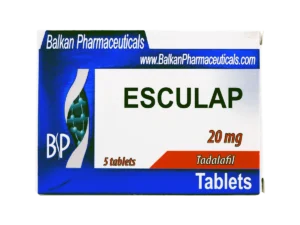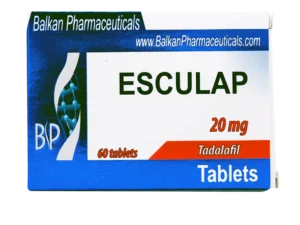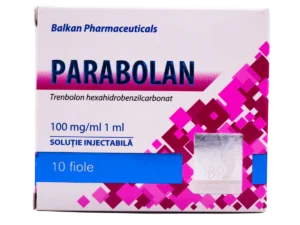Esculap tablets 20 mg
COMMERCIAL NAME Esculap.
International Common Name (ICN) of the active substance Tadalafilum.
COMPOSITION
1 tablet contains:
The active substance: tadalafil – 20 mg;
Excipients: magnesium stearate, Kollidon CL (crospovidone), FD & C Yellow colorant no. 6, Ludipress® (lactose monohydrate, polyvidone, crospovidone).
PHARMACEUTICAL FORM
Tablets.
DESCRIPTION OF THE MEDICINAL PRODUCT
Clear-orange, square-shaped tablets, compact and homogeneous structure with a “BP” split and inlay line on one side of the tablet, with bevelled edges, side with rounded edges. Marble is allowed on the surface of the tablets.
THE PHARMACOTERAPEUTICAL GROUP and the ATC Code
Urological medication. Preparations used in erectile dysfunction, G04BE08.
PHARMACOLOGICAL PROPERTIES
Pharmacodynamic properties
Tadalafil is a selective, reversible inhibitor of cyclic guanosine monophosphate (GMPc) type 5 phosphodiesterase (PDE5). When sexual stimulation causes local release of nitric oxide, inhibition of PDE5 by tadalafil produces increases in GMPc values in the cavern and penis.
As a result, relaxation of the smooth muscles of the arteries and the influx of blood into the tissues of the penis result in erection. Tadalafil does not work in the absence of sexual stimulation.
In vitro studies have shown that tadalafil is a selective PDE5 inhibitor. PDE5 is an enzyme found in the smooth muscles of the cavernous bodies, vascular and visceral smooth muscle, skeletal, thrombocyte, kidney, lung and cerebellum muscles. The effect of tadalafil on PDE5 is stronger than the effect on other phosphodiesterases. Tadalafil is over 10,000 times more selective for PDE5 than for PDE1, PDE2 and PDE4, enzymes found in the heart, brain, blood vessels, liver and other organs. Tadalafil is over 10,000 times more selective for PDE5 than for PDE3, the enzyme found in the heart and the blood vessels. The selectivity for PDE5 compared to PDE3 is important because PDE3 is an enzyme involved in cardiac contractility. In addition, tadalafil is approximately 700 times more selective for PDE5 than for PDE6, an enzyme found in the retina and responsible for phototransduction. Tadalafil is also of over 10,000 times more selective for PDE5 than for PDE7 to PDE10.
Tadalafil improves erectile function and ability to have a successful sexual act. The preparation works for 36 hours. The effect is already visible over 15 minutes after the preparation has been administered to the presence of sexual stimulation.
Tadalafil in healthy subjects does not produce significant differences compared to placebo of systolic and diastolic blood pressure in the lying position (mean decrease of 1.6 mm Hg and 0.8 mm Hg, respectively) and in orthostatism (mean decrease of 0.2 mm Hg and 4.6 mm Hg, respectively).
Tadalafil does not produce any significant change in the frequency of cardiac contractions.
Tadalafil does not produce changes in color perception (blue / green), which is explained by the low affinity of tadalafil for PDE6. Similarly, no influence of tadalafil on visual acuity, electroretinogram, intraocular pressure, and pupil size was determined.
No clinically significant changes in sperm count and sperm concentration, motility, and morphology were determined in male tadalafil studies in the daily dose of 10 mg.
-
-14% Out of stock
 Balkan Pharmaceuticals
Balkan Pharmaceuticals
Pharmacokinetic properties
Tadalafil is rapidly absorbed after oral administration. The mean peak plasma concentrations (Cmax) observed are averaged 2 hours after administration. The rate and extent of absorption of tadalafil are not influenced by food, so tadalafil may be given with or without food. The time of administration (morning or evening) has no clinically relevant effects on the rate and extent of absorption. The pharmacokinetics of tadalafil in healthy subjects is linear in terms of time and dose. In the dose range from 2.5 mg to 20 mg, the area under the “time-concentration curve” (AUC) increases in proportion to the dose.
Steady-state plasma concentrations are reached within 5 days of once daily dosing. The pharmacokinetics of tadalafil in patients with erectile dysfunction are similar to the pharmacokinetics of subjects without erectile dysfunction.
The mean volume of distribution is approximately 63 l, indicating that tadalafil is distributed in tissues.
At therapeutic concentrations, 94% of plasma tadalafil is protein-bound. Protein binding does not change in case of renal dysfunction. There is less than 0.0005% of the administered dose in the sperm of healthy subjects.
Tadalafil is predominantly metabolised by cytochrome P450 (CYP) 3A4 isoenzyme. The major circulating metabolite is methylcatecol glucuronide. This metabolite is at least 13,000 times less selective than tadalafil for PDE5. Consequently, it is not expected to be clinically active at the observed metabolite concentrations.
The mean oral clearance of tadalafil is 2.5 l / h and the mean half-life of elimination half-life is 17.5 hours in healthy subjects. Tadalafil is predominantly excreted as inactive metabolites, mainly in feces (approximately 61% of the dose) and less in urine (approximately 36% of the dose).
Healthy elderly subjects (65 years of age and over) had a lower oral clearance of tadalafil, resulting in a 25% increase in surface area under the “time-concentration curve” (AUC) compared to healthy subjects from 19 to 45 years old. This effect of age is not clinically significant and does not require dose modification.
In subjects with mild renal impairment (creatinine clearance 51-80 ml / min) or moderate (creatinine clearance 31-50 ml / min), the AUC was higher than in healthy subjects. In subjects with severe renal impairment (creatinine clearance below 30 ml / min) tadalafil has not been studied.
The pharmacokinetics of tadalafil in subjects with mild and moderate hepatic impairment are comparable to those in healthy subjects. These patients do not need to adjust the dose.
In patients with diabetes mellitus based on tadalafil, the AUC was approximately 19% lower than that in healthy patients. This difference does not require a dose adjustment.
THERAPEUTICAL INDICATIONS
Treatment of erectile dysfunction in adult men. For tadalafil to be effective, sexual stimulation is required. The use of tadalafil by women is not indicated.
DOSES AND METHOD OF ADMINISTRATION
The preparation is administered internally.
For adult men
Tadalafil is given independently of the body at the initial dose of 20 mg. Patients can perform their sexual activity within 36 hours with the optimal response time for the use of the preparation. A maximum of one administration per day is recommended. No dosage adjustment is required in men over 65 years of age.
Kidney failure.
No dose adjustment is required in patients with mild renal dysfunction. In moderate renal impairment (creatinine clearance 31-50 ml/min), the recommended starting dose is not more than 5 mg/day and maximum 10 mg every 48 hours. In patients with severe renal insufficiency in hemodialysis, the maximum recommended dose is no more than 5 mg.
Hepatic impairment.
In mild or moderate hepatic insufficiency, the maximum dose is 10 mg once daily, and in severe use, the use of the preparation is not recommended, due to the lack of data on the safety of the preparation in this category of patients.
Concomitant therapy.
In patients using strong CYP3A4 inhibitors (for example ketoconazole, ritonavir, etc.) the maximum recommended dose is 10 mg no more frequently than once every 72 hours. The use of tadalafil for concomitant nitrate therapy (up to 48 hours after the last FDE5 inhibitor) or some alpha-adrenoblock (except for tamsulosin 0.4 mg once a day) is contraindicated.
Use in children.
Tadalafil should not be used by people under the age of 18 years.
SIDE EFFECTS
The side effects listed below are classified by frequency, apparatus, system and organ. MedDRA frequency groups: very common (≥ 1/10), common (≥ 1/100 and <1/10), uncommon (≥ 1/1000 and <1/100), rare (≥ 1/10000 and <1/1000) and very rare (<1 / 10,000), not known (can’t be estimated from the available data).
Immune system disorders
Uncommon: hypersensitivity reactions.
Rare: angioedema.
Nervous system disorders
Common: headache.
Uncommon: dizziness.
Rare: strokes, syncope, transient ischemic attacks, migraine, amnesia, convulsions.
Eye disorders
Uncommon: visual disturbances, eye pain.
Rare: change in color perception, conjunctival hyperaemia, conjunctivitis, tachycardia, edema of the face and eyelids.
Acoustic and vestibular disorders
Uncommon: tinnitus.
Rare: loss of balance.
Cardiac disorders
Uncommon: tachycardia, palpitations.
Rare: myocardial infarction, unstable angina, ventricular arrhythmias.
Vascular disorders
Uncommon: orthostatic hypotension, hypertension.
Rare: syncope.
Respiratory, thoracic and mediastinal disorders
Uncommon: Nasal congestion.
Rare: dyspnoea, epistaxis.
Gastrointestinal disorders
Common: dyspepsia, gastroesophageal reflux.
Uncommon: abdominal pain.
Skin and subcutaneous tissue disorders
Uncommon: erythema, sweating.
Rare: urticaria, Stevens-Johnson syndrome, exfoliative dermatitis.
Musculoskeletal and connective tissue disorders
Uncommon: back pain, myalgia, pain in expirities.
Renal and urinary disorders
Uncommon: haematuria.Reproductive system and breast disorders
Uncommon: penile haemorrhage, hematospermia.
Rare: prolonged erections, priapism.
General disorders at the site of administration.
Uncommon: chest pain.
Rare: facial swelling, sudden cardiac death.
CONTRAINDICATIONS
– hypersensitivity to tadalafil or to any of the components of the preparation;
– concomitant administration of preparations containing any organic nitrate;
– concomitant treatment with alpha-adrenoblocks (except for tamsulosin 0.4 mg once a day);
– under 18 years of age.
OVERDOSE
Symptoms: When tadalafil is given to healthy subjects at single doses of up to 500 mg, and in patients with dysfunction – multiple daily doses up to 100 mg, adverse reactions were similar to those seen at lower doses.
Treatment: Specific antidote is not. The treatment is symptomatic. Hemodialysis insignificantly accelerates the elimination of tadalafil.
SPECIAL WARNINGS AND PRECAUTIONS FOR USE
Sexual activity is associated with a certain degree of risk in patients with cardiovascular disease. Thus, medicines for the treatment of erectile dysfunction, including tadalafil, should not be used in men with cardiac disease not recommended for sexual activity.
Must be consider the potential cardiac risk of sexual activity in patients with pre-existing cardiovascular disease:
– myocardial infarction occurred within the last 90 days;
– unstable angina or angina pectoris that occurs during sexual intercourse;
– class II heart failure after or over NYHA, occurring within the last 6 months;
– uncontrolled arrhythmias, hypotension (TA<90/50mm Hg) or uncontrolled hypertension;
– stroke occurred within the last 6 months.
Tadalafil should be used with caution in patients with predisposing conditions (such as pancytic anemia, multiple myeloma or leukemia), or in patients with anatomical penile deformities (such as angulation, cavernous fibrosis or Peyronie’s disease).
Cases of priapism have been reported with the use of another PDE5 inhibitor – sildenafil, although no cases of priapism have been reported on the background of tadalafil administration. Patients should be instructed to seek immediate medical attention if they have erections lasting 4 hours or longer. If priapism is not treated immediately, it can cause penile tissue damage and permanent loss of potency. The safety and efficacy of the association of tadalafil with other treatments for erectile dysfunction have not been studied. Therefore, the use of these associations is not recommended.
Tadalafil is used with caution in degenerative congenital malignancies of the retina, including pigmented retinitis. Based on tadalafil treatment in patients with moderate renal impairment (creatinine clearance of 31-50 ml/min) more commonly reported as adverse reactions as back pain, compared with patients with mild renal impairment (clearance creatinine 51-80 ml / min) or in healthy subjects. Therefore, tadalafil should be cautiously indicated in patients with creatinine clearance below 50 ml/min.
This medicine contains lactose. Patients with rare hereditary problems of galactose intolerance, Lapp lactase deficiency (Lapp), or glucose-galactose malabsorption should not take this medicine.
The tablets contain FD & C Yellow # 6, which can cause allergic reactions.
Pregnancy and lactation Tadalafil is not indicated for use by women.
Influence on the ability to drive and use machines
With regard to the fact that tadalafil can cause asthenia and drowsiness, it is advisable that these symptoms appear to be cautious, when conducting the car or performing activities that require increased attention.
INTERACTIONS WITH OTHER MEDICINES AND OTHER TYPES OF INTERACTION
Effects of other substances on tadalafil
Tadalafil is primarily metabolised by CYP3A4. Ketoconazole, a selective CYP3A4 inhibitor, increases tadalafil AUC by 107% and rifampicin decreases by 88%.
Although specific interactions have not been studied, it can be assumed that protease inhibitors such as ritonavir and saquinavir, as well as other CYP3A4 inhibitors such as erythromycin and itraconazole, may increase the activity of tadalafil.
Concomitant administration of antacids (magnesium and aluminum hydroxide) reduces the absorption rate of tadalafil without altering the AUC. The increase in gastric pH as a consequence of the administration of the H2-histaminoblock nasatidine did not influence the pharmacokinetics of tadalafil.
The effects of tadalafil on other medicines
It is known that tadalafil enhances the hypotensive effects of nitrates (nitroglycerin, isosorbid dinitrate, isosorbide mononitrate). This occurs as a result of the additive action of nitrates and tadalafil on the metabolism of nitrogen monoxide and GMPc. Therefore, administration of tadalafil to patients using any form of organic nitrate is contraindicated.
Tadalafil does not clinically significantly affect the clearance of drugs metabolised by cytochrome P450 isoenzymes. Studies have confirmed that tadalafil does not inhibit or induce the CYP3A4, CYP1A2, CYP2D6, CYP2E1 and CYP2C9 isoenzymes.
Tadalafil has no clinically significant effect on the pharmacokinetics of S-warfarin or R-warfarin and does not affect the warfarin-induced changes in prothrombin time. Tadalafil does not increase the time bleeding caused by acetylsalicylic acid.
Tadalafil does not clinically interact significantly with major classes of antihypertensive agents, including calcium channel blockers (amlodipine), angiotensin converting enzyme (enalapril) inhibitors, beta-adrenergic receptor blockers (metoprolol), alpha-blockers, thiazide diuretics (bendrofluazid) angiotensin II receptors, which have been used in various doses as monotherapy or in associations. Data analysis did not reveal a difference in adverse reactions in patients who used tadalafil with or without antihypertensive medication.
No influence of single dose administration of tadalafil on the concentration of ethyl alcohol in the blood, the effect of alcohol on cognitive function and blood pressure was determined. In addition, no changes were noted of the tadalafil plasma concentration at 3 hours after concomitant administration of alcohol.
Tadalafil does not significantly alter the pharmacokinetics or pharmacodynamics of theophylline.
PRESENTATION, PACKAGING
20 mg tablets.
Two (2) or five (5) tablets in a blister. One (1) blister together with the instruction for administration in a folding carton box.
Twenty (20) tablets in the blister. One (1) or three (3) blister packs together with the instruction for administration in a folding carton box.
STORAGE
Keep at temperatures below 25 °C.
Keep out of the reach and sight of children!
TERMS OF VALIDITY
3 years. Do not use after the expiry date stated on the pack.
LEGAL STATUS
With prescription.
CERTIFICATE OF REGISTRATION
SC Balkan Pharmaceuticals SRL N. Grădescu str., 4, MD-2002, or. Chisinau, Republic of Moldova.
The manufacturer SC Balkan Pharmaceuticals SRL Industrial Street, 7 / A, MD-2091, or. Singera, Republic of Moldova.
This product you can buy here.







